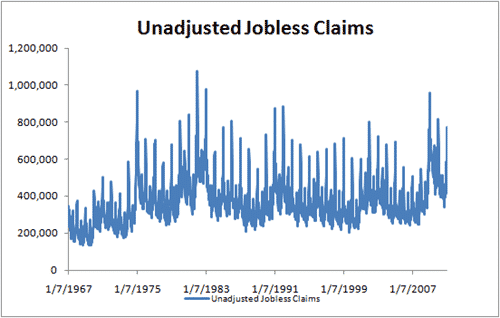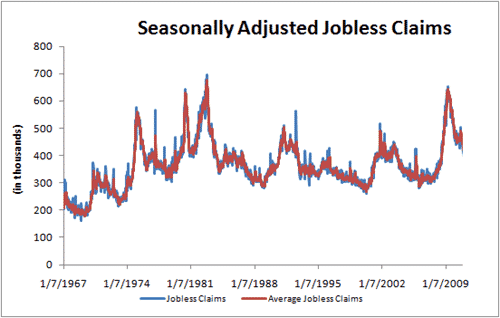Why are jobless claims so high this week; Is the government data fudging?
Actually I hadn’t intended to write this post but this week and last week I have seen a few comments on Twitter questioning the government’s employment numbers. That made me think it’s a good time to review the US Government’s seasonal adjustments given how high initial jobless claims were this week.
Let me say at the outset I don’t think the US government’s seasonal adjustments are accurate. Nevertheless, I will say this: they are close enough for me, especially when looking at trends instead of absolute levels. What I’m concerned about is the direction of the numbers more than the level. If the unemployment rate or jobless claims are going up that’s bad, if they are going down, that’s good.
As for the actual numbers, jobless claims are about as clean and real time a number as you are going to get. I like this data set. The states tally up how many people filed claims for unemployment insurance and pass this on to the federal government. The US federal government then seasonally-adjusts this number based on a factor that they work out well in advance of the jobless claims report. For example, the seasonal adjustment factors are already set through 2 April 2011. Between now and then, the US Department of Labor will release an updated seasonal adjustment chart through to the end of 2011.
I think it is important to realize that the adjustments are made well in advance for two reasons:
- This is the source of inaccuracy. There is no way you can seasonally adjust a holiday season jobless claims number ten months in advance going into or exiting a downturn with great accuracy. It’s not doable. That doesn’t mean that the statisticians have any nefarious designs in making their initial adjustment factors. It’s just that the economy is too complex to make these calculations with that much of a lead time.
- The only way the jobless claims number can really be ‘manipulated’ is by under- or over-reporting from the states. The states release their numbers separately and the Feds just compile these numbers and seasonally adjust them. So unless you think some state is faking their numbers, there is absolutely no reason to doubt the composite number.
So, this past week’s (seasonally-adjusted) initial claims number was 445,000. That’s not a good number. It is 35,000 more than last week and 34,000 above the moving average. However, the real number of first time claims for unemployment insurance was an eye-popping 770, 413. Get it? 325,000 MORE than the adjusted number. One econblogger called this "data fudging extraordinaire". Is it?
You tell me. Here are the charts for non-seasonally adjusted initial claims (i.e. the real numbers)
and for adjusted initial claims.
What you should notice from these two charts is that the jobs market is very, very seasonal. Basically it jumps up every holiday season and then drops back into the summer. It happens this way every year. So when you see a big number like 770,000, it’s due to seasonality. Last week, I mentioned this, writing:
we are in a heavy seasonal adjustment period. The seasonal factor for this past week’s number was 141.0. Next week will see the heaviest adjustment as seasonal jobs come to an end. We won’t get a normal number until early February.
The seasonal adjustment was a massive 173.0 this past week making 770,413 magically turn into a much nicer 445,000. In plain English, that means for every 173 people who filed first time jobless claims, the stats guys reported only 100 filings in order to make this number an apples to apples comparison with all the other numbers during the year. It’s like when they told you that 453,000 filed for benefits for the first time in the week ended 11 Sep 2010 when in fact only 341,664 people did. That week saw the lowest seasonal adjustment factor for the year of 75.5.
So here’s my take: if you look at the numbers on a year-over-year basis, we are looking better than in 2010 or 2009 but not anywhere close to what we saw before that. Here are the comparable numbers for the past twelve years. They have always been the highest number for the year.
Non-seasonally adjusted initial jobless claims
(Week ended)
8 Jan 2011: 770,413
9 Jan 2010: 815,593
10 Jan 2009: 956,791
12 Jan 2008: 547,943
13 Jan 2007: 506,709
7 Jan 2006: 555,114
8 Jan 2005: 693,776
10 Jan 2004: 677,897
11 Jan 2003: 724,111
12 Jan 2002: 799,246
13 Jan 2001: 599,562
8 Jan 2000: 606,897
Notice how each and every one of these numbers is above 500,000 in good times and bad. Look, I tend to be a sceptical sort. But there is no conspiracy here. No one is doctoring the numbers. The US jobs picture is improved but remains relatively weak.


Comments are closed.